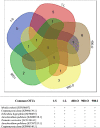Fungi in perennial ice from Scărișoara Ice Cave (Romania)
- PMID: 29973683
- PMCID: PMC6031636
- DOI: 10.1038/s41598-018-28401-1
Fungi in perennial ice from Scărișoara Ice Cave (Romania)
Abstract
Screening of 1,000-years old ice layers from the perennial ice block of Scărișoara Ice Cave (NW Romania) revealed the presence of fungal communities. Using culture-dependent methods and molecular techniques based on DGGE fingerprinting of 18S rRNA gene fragments and sequencing, we identified 50 cultured and 14 uncultured fungi in presently-forming, 400 and 900 years old ice layers, corresponding to 28 distinct operational taxonomic units (OTUs). The dominant ice-contained fungal OTUs were related to Ascomycota, Basidiomycota and Cryptomycota phyla. Representatives of Mucoromycota and Chytridiomycota were also isolated from recent and 400 years old ice samples. The cryophilic Mrakia stokesii was the most abundant fungal species found in the cave ice samples of all prospected ages, alongside other cryophilic fungi also identified in various glacial environments. Ice deposits formed during the Little Ice Age (dated between AD 1,250 and 1,850) appeared to have a higher fungal diversity than the ice layer formed during the Medieval Warm Period (prior to AD 1,250). A more complex fungal community adapted to low temperatures was obtained from all analyzed ice layers when cultivated at 4 °C as compared to 15 °C, suggesting the dominance of cold-adapted fungi in this glacial habitat. The fungal distribution in the analyzed cave ice layers revealed the presence of unique OTUs in different aged-formed ice deposits, as a first hint for putative further identification of fungal biomarkers for climate variations in this icy habitat. This is the first report on fungi from a rock-hosted cave ice block.
Conflict of interest statement
The authors declare no competing interests.
Figures



References
-
- Abyzov, S. S. Microorganisms in the Antarctic ice in Antarctic Microbiology (ed. Friedmann, E. I.) 265-295 (Wiley-Liss, Inc., 1993).
-
- Priscu, J. C., Christner, B. C., Foreman, C. M. & Royston-Bishop, G. Biological material in ice cores in Encyclopedia of Quaternary Science. (ed. Elias S. A.) 1156–1167 (Elsevier, 2007).
Publication types
MeSH terms
Substances
Grants and funding
- PN-II-ID-PCE-2011-3-074/Unitatea Executiva pentru Finantarea Invatamantului Superior, a Cercetarii, Dezvoltarii si Inovarii (Executive Agency for Higher Education, Scientific Research, Development and Innovation Funding)/International
- ELAC2014_DCC-0178/EC | Horizon 2020 (European Union Framework Programme for Research and Innovation)/International
LinkOut - more resources
Full Text Sources
Other Literature Sources
Medical

